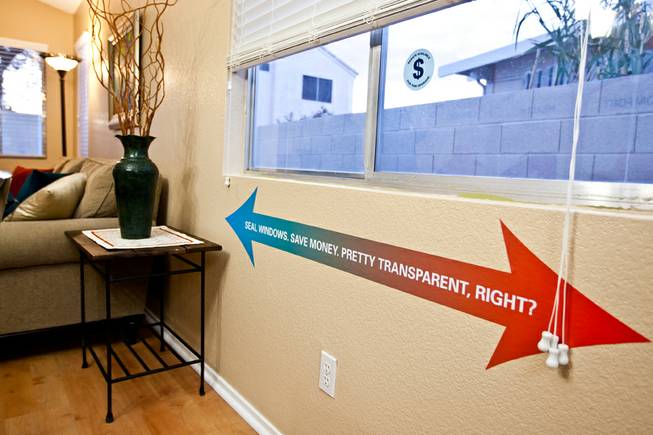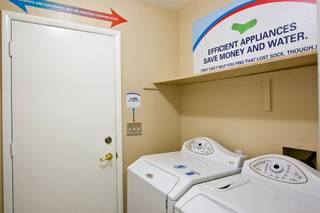
Mona Shield Payne
Draft-sealed windows are shown during a green house tour of the latest energy-efficient technological changes in a residential home in North Las Vegas Monday, November 4, 2013.
Sunday, Nov. 17, 2013 | 2 a.m.
Turning off the lights. Unplugging electronics. Closing the blinds on a blazing-hot day.
Those are the hallmarks of energy conservationism, slight changes in behavior that can reduce energy consumption and save money. With a little extra investment, however, homeowners can decrease their energy use even more with simple energy-efficient upgrades.
“Energy efficiency is really simple stuff you can do in your home without spending much,” said Denee Evans, executive director of HomeFree Nevada, a nonprofit that seeks to improve energy efficiency and conservation in Nevada homes.
The one-story house at 5115 Palo Pinto Lane in North Las Vegas boasts the latest gadgets to spark savings, making it a model of energy efficiency. The home recently hosted a bevy of North Las Vegas and state leaders, who kicked off its months-long run as an education tool for the community.
Paul Thomsen, director of the Governor’s Office of Energy, also announced a $2,000 rebate — double the amount normally offered — for the first 150 people who sign up for EnergyFit Nevada, participate in a home audit and implement the recommendations. EnergyFit Nevada is run by HomeFree Nevada.
North Las Vegas acquired the foreclosed home in 2011 through the federal Neighborhood Stabilization Program. The city then donated grant money to EnergyFit Nevada to retrofit the house with energy-efficient technologies. The result: a 27-percent energy-use reduction in the 1,300-square-foot home.
In addition to cheaper utility bills, an EnergyFit analysis found that green upgrades could boost a home’s resale value by $5,000 to $13,000.
The North Las Vegas home will be put up for sale in late spring or early summer, officials said. Until then, people interested in scheduling a tour or signing up for an EnergyFit Nevada assessment of their own homes can visit energyfitnevada.org.
Interested in going green? Here are a few energy-efficient upgrades included in the North Las Vegas house that you can try in your home:
-
Dual-flush toilet
This throne is very similar to a standard toilet but includes a water-smart flushing mechanism.
Two push buttons on top of the tank let users choose either a half flush or full flush depending on the type of waste. A half flush uses about 20 percent less water than a standard flush, said Marc Hale, a home performance expert with Today’s Energy Store.
Water-saving toilets entered the marketplace more than a dozen years ago but are starting to become more popular.
“Obviously in Southern Nevada, water saving is huge,” Hale said. “You would think this would catch on and be mandated for homes.”
Cost: $100 to $500 per toilet, depending on brand
-
Energy-efficient washer and dryer
Washers and dryers etched with a blue Energy Star emblem meet high levels of energy efficiency set by the U.S. Environmental Protection Agency.
Energy-efficient washing machines run shorter cycles and use less water to clean dirty laundry. They spin extremely fast so that clothes are no longer sopping at the end of the cycle, Hale said. As a result, dryers don’t have to run as long.
Many energy-efficient dryers also contain sensors that can tell when laundry is dry and stop the cycle, he said.
The combined efforts of high-tech washers and dryers result in a 5 to 8 percent reduction in energy use, Hale said.
Cost: About $800 per appliance
-
Programmable thermostat
Programmable thermostats keep homes at a comfortable temperature even when residents are away. No more walking into a frigid house after work or getting too toasty during the night.
Users can program the thermostat to start warming or cooling the home at a specific time.
Scheduling temperature changes rather than blasting heat or air when you need it immediately can save 3 to 5 percent in energy costs, Hale said.
One model, made by Nest, even learns homeowners’ habits and programs itself to automatically adjust house temperature. The Nest thermostat can lower heating and cooling bills by up to 20 percent, according to the company's website.
Cost: $50 to $300, depending on model
-
Tinted windows
In Southern Nevada’s desert climate, it doesn’t take long for the sun to heat up a room. Tinted windows deflect the sun’s rays, lessening the burden on air conditioning units.
Aside from keeping rooms cooler, tinted windows also block ultraviolet rays, which protects belongings from sun damage and fading, Hale said.
Tinted windows can save 2 to 4 percent in energy costs, Hale said.
Cost: About $600 to tint every windows in a 1,500-square-foot home
-
Energy-efficient light bulbs
When energy-efficient light bulbs first hit the marketplace, some consumers complained about the type of light they cast. It was too harsh, critics said.
That’s no longer an excuse. Nowadays, energy-efficient light bulbs come in a variety of hues, including “soft white,” “daylight” and “cool white.”
Light bulbs that earn Energy Star ratings will save about $6 in electricity costs each year. They fit in almost any standard fixture.
Cost: $3 and up per bulb


Join the Discussion:
Check this out for a full explanation of our conversion to the LiveFyre commenting system and instructions on how to sign up for an account.
Full comments policy